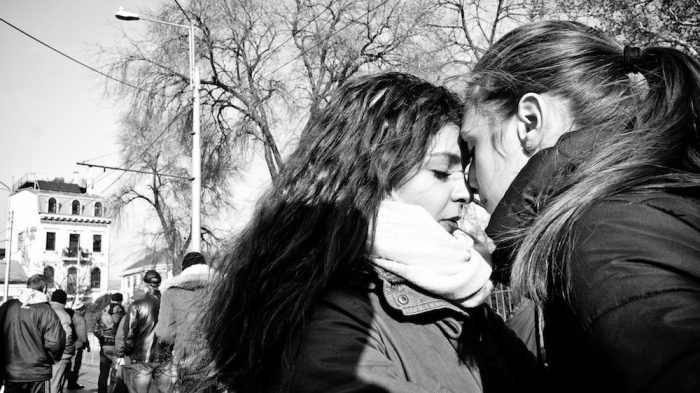Warning: salty language ahead!
~
I kept staring at the words, but they wouldn’t change:
“Letting Go in Love: a Codependent’s Journey to Nonattachment.”
I immediately entered full-blown panic mode—my codependency was featured in the title of my article on Elephant Journal, front and center for everyone to see. It was one thing to write about my codependency—you’d have to actually read the article to find out—but being outed by a title in giant letters was not my plan.
As my heart raced and my hands shook, a shame shitstorm overwhelmed me, and there wasn’t a damn thing I could do about it. Options raced through my mind faster than I could process them: Change the title. Pull the article. Leave the country. They all seemed appealing.
I needed to calm down. Just breathe, David. I’d come face-to-face with the true meaning of vulnerability, and it was kicking my ass.
What’s wrong with you? You’re a failure and a fraud. All the work you’ve done is worthless.
These thoughts were the hands around my throat that kept me breathless. As the seconds ticked by, panic turned to terror as I considered the consequences that were sure to follow.
What will people think? I’m damaged, and everyone will know it. Will this affect my job?
I wanted to disappear in the worst way. I had thought I’d made significant progress, only to discover that I’d been dabbling in the vulnerability pool and inadvertently found myself tossed into the deep end—but I didn’t know how to swim, flailing around as I tried to stay afloat.
Turns out I preferred to practice my vulnerability privately.
But fuck. That’s the whole point.
Exposing our true selves can be terrifying—sometimes we try to control it by limiting how much we’re willing to share and to whom. We hedge—wanting to go out on a limb, but not so far that it breaks and we get hurt. I’d planned to ease my way into it by writing something uncomfortable, as long as my words were hidden safely beneath a nondescript title.
But vulnerability is defined by the times we wonder how the fuck we can share something—when our mouths go dry, our hearts race, and our self-esteem is on the line. Showing up as our authentic selves with our dysfunction, flaws, and failures intact is one of the scariest things we can do, and exactly why being vulnerable is so difficult.
We can watch all the TED Talks and read all the books, but that doesn’t do shit unless we can put it into practice. It’s the difference between learning about vulnerability and becoming vulnerable, and it’s the only thing that really matters, the only way we’ll have the deep, meaningful connections we crave.
For those of us trying to heal old wounds and self-esteem issues, exposing our bruised and battered hearts is not easy. But we’re not alone. So many of us struggle silently—afraid if we appear too damaged we won’t be worthy of belonging. But it’s this fear of unworthiness that keeps us isolated, and the truth is that vulnerability is the bridge that connects us.
Becoming deeply authentic was hard for me. I’d always been a “highlight reel” guy—sharing my dysfunction didn’t seem like a great way to make friends and influence people. But I worked hard on being honest with myself about my childhood wounds, my flaws, and who I really was. What I was doing was practicing vulnerability.
I learned to let go of the perfectionism that drove my adult relationships. I’d spent my life thinking there was no way I’d be loved if anyone knew my insecurities, my codependency, and my shame—and I kept those parts of myself hidden. It was incredibly isolating, and cost me any chance at the intimacy I’d always wanted.
If you really believe in the shit you’ve been working on, this is going to have to be okay.
I had to work hard enough to believe that I was enough and that showing up as my true self wouldn’t be the end of me. This faith in my recovery is what pulled me back from the edge of terror when my article was published—I’d decided to leave it as it was and no matter what happened, I’d be okay.
I’d come to believe that If we want to practice vulnerability, we have to let go of the belief that we’re not enough as we are. Building self-trust, mixed with a healthy dose of courage, is what allows us to step into vulnerability.
Feeling afraid to share parts of ourselves we’ve always kept hidden is a necessary part of the process. I’d mistakenly believed that fear was the signal to withdraw into isolation and protect myself. I never understood that fear is what defines vulnerability, and, excruciating as it can be, is part of the risk we take to make the connections we crave.
Not everyone deserves our story. I shared parts of myself I’d kept hidden with an ex-partner who called it “bullshit,” and it stung. But it also clarified why learning to identify safe people for us to share with is important—for me, it was my therapist, but it can be anyone we trust. It’s hard enough taking vulnerability out of theory and putting it into practice—we need to give ourselves the best chance to succeed.
Protecting our true selves from exposure won’t keep us from getting hurt. I spent my adult life hiding my flaws and avoiding vulnerability, and I suffered excruciating heartbreak and loss. It was only after learning to become vulnerable that I learned how important it was to have the meaningful relationships I always wanted.
We’re never truly connected if we don’t let ourselves be seen. Becoming vulnerable through my writing taught me I was not alone—we are not alone. I held my breath and took a chance by showing up authentically—and I learned that deeper connections wait for us on the other side of the bridge, if we’re willing to find the courage and choose to show up exactly as we are. Without apology. Without shame. Imperfect, beautiful, and real.
In our vulnerability, we find connection. And only then are we truly, finally seen.
 Share on bsky
Share on bsky






Read 44 comments and reply